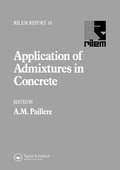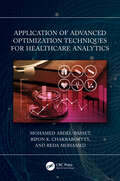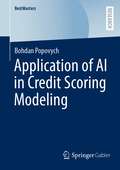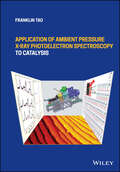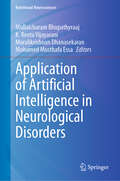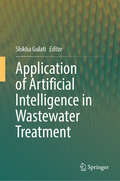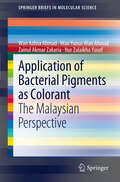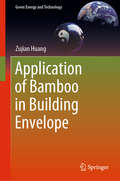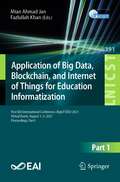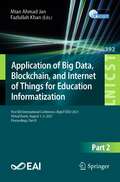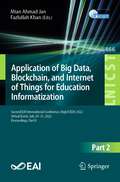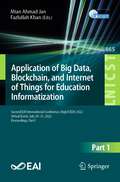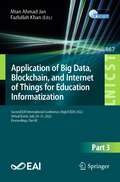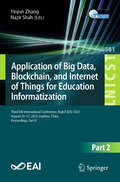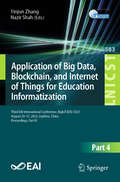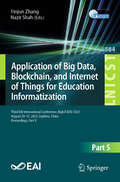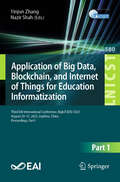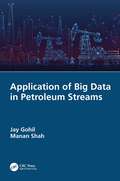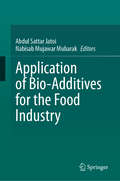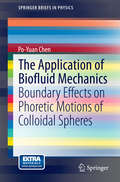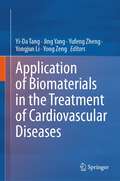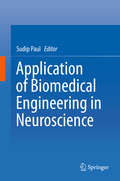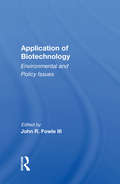- Table View
- List View
Application of Admixtures in Concrete
by A. M. PaillèreThis book provides a thorough review of the properties and use of the principal chemical admixtures for use in concrete. Concise and clearly presented, the book includes extensive references to key sources of information. The presentation of each admixture is in a standard format, which helps the reader to find relevant information easily.
Application of Advanced Optimization Techniques for Healthcare Analytics
by Mohamed Abdel-Basset Ripon K. Chakrabortty Reda MohamedApplication of Advanced Optimization Techniques for Healthcare Analytics, 1st Edition, is an excellent compilation of current and advanced optimization techniques which can readily be applied to solve different hospital management problems. The healthcare system is currently a topic of significant investigation to make life easier for those who are disabled, old, or sick, as well as for young children. The emphasis of the healthcare system has evolved throughout time due to several emerging beneficial technologies, such as personal digital assistants (PDAs), data mining, the internet of things, metaheuristics, fog computing, and cloud computing. Metaheuristics are strong technology for tackling several optimization problems in various fields, especially healthcare systems. The primary advantage of metaheuristic algorithms is their ability to find a better solution to a healthcare problem and their ability to consume as little time as possible. In addition, metaheuristics are more flexible compared to several other optimization techniques. These algorithms are not related to a specific optimization problem but could be applied to any optimization problem by making some small adaptations to become suitable to tackle it. The successful outcome of this book will enable a decision-maker or practitioner to pick a suitable optimization approach when making decisions to schedule patients under crowding environments with minimized human errors.
Application of AI in Credit Scoring Modeling (BestMasters)
by Bohdan PopovychThe scope of this study is to investigate the capability of AI methods to accurately detect and predict credit risks based on retail borrowers' features. The comparison of logistic regression, decision tree, and random forest showed that machine learning methods are able to predict credit defaults of individuals more accurately than the logit model. Furthermore, it was demonstrated how random forest and decision tree models were more sensitive in detecting default borrowers.
Application of Ambient Pressure X-ray Photoelectron Spectroscopy to Catalysis
by Franklin TaoAPPLICATION OF AMBIENT PRESSURE X-RAY PHOTOELECTRON SPECTROSCOPY TO CATALYSIS Authoritative and detailed reference on ambient-pressure x-ray photoelectron spectroscopy for practitioners and researchers starting in the field Application of Ambient Pressure X-ray Photoelectron Spectroscopy to Catalysis introduces a relatively new analytical method and its applications to chemistry, energy, environmental, and materials sciences, particularly the field of heterogeneous catalysis, covering its background and historical development, its principles, the instrumentation required to use it, analysis of data collected with it, and the challenges it faces. The features of this method are described early in the text; the starting chapters provide a base for understanding how AP-XPS tracks crucial information in terms of the surface of a catalyst during catalysis. The second half of this book delves into the specific applications of AP-XPS to fundamental studies of different catalytic reactions. In later chapters, the focus is on how AP-XPS could provide key information toward understanding catalytic mechanisms. To aid in reader comprehension, the takeaways of each chapter are underlined. In Application of Ambient Pressure X-ray Photoelectron Spectroscopy to Catalysis, readers can expect to find detailed information on specific topics such as: Going from surface of model catalyst in UHV to surface of nanoparticle catalyst during catalysis Application of XPS from surface in UHV to surface in gas or liquid phase and fundamentals of X-ray spectroscopy Significance and challenges of studying surface of a catalyst in gaseous phase and instrumentation of ambient pressure X-ray photoelectron spectrometers Experimental methods of AP-XPS studies and difference in data analysis between AP-XPS and high vacuum XPS Ambient Pressure X-Ray Photoelectron Spectroscopy is an ideal resource for entry level researchers and students involved in x-ray photoelectron spectroscopy. Additionally, the text will appeal to scientists in more senior roles in academic and government laboratory institutions in the fields of chemistry, chemical engineering, energy science, and materials science.
The Application of Artificial Intelligence: Step-by-Step Guide from Beginner to Expert
by Zoltán SomogyiThis book presents a unique, understandable view of machine learning using many practical examples and access to free professional software and open source code. The user-friendly software can immediately be used to apply everything you learn in the book without the need for programming.After an introduction to machine learning and artificial intelligence, the chapters in Part II present deeper explanations of machine learning algorithms, performance evaluation of machine learning models, and how to consider data in machine learning environments. In Part III the author explains automatic speech recognition, and in Part IV biometrics recognition, face- and speaker-recognition. By Part V the author can then explain machine learning by example, he offers cases from real-world applications, problems, and techniques, such as anomaly detection and root cause analyses, business process improvement, detecting and predicting diseases, recommendation AI, several engineering applications, predictive maintenance, automatically classifying datasets, dimensionality reduction, and image recognition. Finally, in Part VI he offers a detailed explanation of the AI-TOOLKIT, software he developed that allows the reader to test and study the examples in the book and the application of machine learning in professional environments.The author introduces core machine learning concepts and supports these with practical examples of their use, so professionals will appreciate his approach and use the book for self-study. It will also be useful as a supplementary resource for advanced undergraduate and graduate courses on machine learning and artificial intelligence.
Application of Artificial Intelligence in Neurological Disorders (Nutritional Neurosciences)
by Muralikrishnan Dhanasekaran Mullaicharam Bhupathyraaj K. Reeta Vijayarani Mohamed Musthafa EssaThis book discusses the role of artificial intelligence in neurological disorders, including, alleviating movement disorders, psychiatric disorders, diagnosis of neurological and neurodegenerative disorders, dementia, neuronal cancer, neuronal Infections, and brain diseases. It explores applications of artificial intelligence in the early diagnosis, prognosis, and development of new therapies against neurodegenerative disorders. This book also provides cutting-edge research using AI for studying neuroimage analysis, toward the discovery of new biological pathways and systems implicated in dementia and related diseases. It also reviews AI-based interventions in depression research and treatment. The chapter also examines the potential benefits of using AI to help manage depression, from improved access to coordinated care. This book is an essential source for students, researchers, academicians, and neurologists aiming to understand AI-based approaches for the diagnosis, treatment, and prevention of neurological disorders.
Application of Artificial Intelligence in Wastewater Treatment
by Shikha GulatiThis book offers a comprehensive exploration of the integration of artificial intelligence (AI) techniques in addressing challenges and optimizing processes within wastewater treatment. The coverage of the book spans a spectrum of applications, including AI-driven monitoring and control systems, predictive modeling for pollutant removal, and the development of smart sensor networks for real-time data analysis in wastewater treatment plants. By amalgamating AI methodologies with wastewater treatment processes, the book provides insights into enhancing efficiency, reducing costs, and mitigating environmental impacts. In the current research scenario, the theme of the book is highly pertinent as it responds to the pressing need for sustainable and efficient wastewater treatment solutions. The book defines the theme by elucidating how AI technologies, such as machine learning algorithms and data analytics, can revolutionize wastewater treatment processes by enabling proactive decision-making, optimizing resource allocation, and predicting potential system failures. This intersection of AI and wastewater treatment not only addresses operational challenges but also contributes to the broader goal of achieving environmentally conscious and economically viable solutions.
Application of Bacterial Pigments as Colorant: The Malaysian Perspective (SpringerBriefs in Molecular Science)
by Wan Yunus Wan Ahmad Wan Azlina Ahmad Zainul Akmar Zakaria Nur Zulaikha YusofEnvironmental concerns regarding continuous use of synthetic dyes saw a revival in the demand for natural dyes as natural dyes exhibit better biodegradability and generally have a higher compatibility with the environment. However, one of the limitations on the use of natural dyes or pigments is the low extraction yield factors (a few grams of pigment per kg of dried raw material). Therefore, the exploitation of other biological sources such as fungi, bacteria and cell cultures offers interesting alternative. Microbial pigments such as from bacterial origins offer the advantage in terms of production compared to pigments extracted from vegetables or animals, due to its simple cell and fast culturing technique. This book offers interesting insight into initial works carried out to demonstrate the potential use of bacterial pigment as colorant for various applications.
Application of Bamboo in Building Envelope (Green Energy and Technology)
by Zujian HuangThis book offers a comprehensive overview of the use of bamboo in building industry. It systematically demonstrates bamboo’s utility in terms of its properties, describing the material properties of typical industrial bamboo products, and discussing their performance evaluation and optimization as building components and in the creation of building envelopes. The book also includes examples of the high-value utilization of bamboo forest resources. Further, it examines how building performance may be affected by conditions such as climate. Including insights from material science, construction design, building physics and building climatology, the book also provides data obtained from technology and market status investigation, laboratory test and the computer simulation.This book appeals to scientists and professionals, as it introduces and tests various bamboo products, demonstrating the advantages and disadvantages for each one. The book is also a valuable resource for civil engineers and students interested in this unique plant material and its application in the building industry.
Application of Big Data, Blockchain, and Internet of Things for Education Informatization: First EAI International Conference, BigIoT-EDU 2021, Virtual Event, August 1–3, 2021, Proceedings, Part I (Lecture Notes of the Institute for Computer Sciences, Social Informatics and Telecommunications Engineering #391)
by Mian Ahmad Jan Fazlullah KhanThis two-volume set constitutes the refereed proceedings of the First International Conference International Conference on Application of Big Data, Blockchain, and Internet of Things for Education Informatization. The conference was held in August 2021 and due to COVID-19 pandemic virtually.The 99 revised full papers and 45 short papers have been selected from 503 submissions. The papers describe research fields such as “big data” and “information education”. The aim of the conference is to provide international cooperation and exchange platforms for big data and information education experts, scholars and enterprise developers to share research results, discuss existing problems and challenges, and explore cutting-edge science and technology.
Application of Big Data, Blockchain, and Internet of Things for Education Informatization: First EAI International Conference, BigIoT-EDU 2021, Virtual Event, August 1–3, 2021, Proceedings, Part II (Lecture Notes of the Institute for Computer Sciences, Social Informatics and Telecommunications Engineering #392)
by Mian Ahmad Jan Fazlullah KhanThis two-volume set constitutes the refereed proceedings of the First International Conference International Conference on Application of Big Data, Blockchain, and Internet of Things for Education Informatization. The conference was held in August 2021 and due to COVID-19 pandemic virtually. The 99 revised full papers and 45 short papers have been selected from 503 submissions. The papers describe research fields such as “big data” and “information education”. The aim of the conference is to provide international cooperation and exchange platforms for big data and information education experts, scholars and enterprise developers to share research results, discuss existing problems and challenges, and explore cutting-edge science and technology.
Application of Big Data, Blockchain, and Internet of Things for Education Informatization: Second EAI International Conference, BigIoT-EDU 2022, Virtual Event, July 29–31, 2022, Proceedings, Part II (Lecture Notes of the Institute for Computer Sciences, Social Informatics and Telecommunications Engineering #466)
by Mian Ahmad Jan Fazlullah KhanThe three-volume set LNICST 465, 466 and 467 constitutes the proceedings of the Second EAI International Conference on Application of Big Data, Blockchain, and Internet of Things for Education Informatization, BigIoT-EDU 2022, held as virtual event, in July 29–31, 2022. The 204 papers presented in the proceedings were carefully reviewed and selected from 550 submissions. BigIoT-EDU aims to provide international cooperation and exchange platform for big data and information education experts, scholars and enterprise developers to share research results, discuss existing problems and challenges, and explore cutting-edge science and technology. The conference focuses on research fields such as “Big Data” and “Information Education. The use of Artificial Intelligence (AI), Blockchain and network security lies at the heart of this conference as we focused on these emerging technologies to excel the progress of Big Data and information education.
Application of Big Data, Blockchain, and Internet of Things for Education Informatization: Second EAI International Conference, BigIoT-EDU 2022, Virtual Event, July 29–31, 2022, Proceedings, Part I (Lecture Notes of the Institute for Computer Sciences, Social Informatics and Telecommunications Engineering #465)
by Mian Ahmad Jan Fazlullah KhanThe three-volume set LNICST 465, 466 and 467 constitutes the proceedings of the Second EAI International Conference on Application of Big Data, Blockchain, and Internet of Things for Education Informatization, BigIoT-EDU 2022, held as virtual event, in July 29–31, 2022. The 204 papers presented in the proceedings were carefully reviewed and selected from 550 submissions. BigIoT-EDU aims to provide international cooperation and exchange platform for big data and information education experts, scholars and enterprise developers to share research results, discuss existing problems and challenges, and explore cutting-edge science and technology. The conference focuses on research fields such as “Big Data” and “Information Education. The use of Artificial Intelligence (AI), Blockchain and network security lies at the heart of this conference as we focused on these emerging technologies to excel the progress of Big Data and information education.
Application of Big Data, Blockchain, and Internet of Things for Education Informatization: Second EAI International Conference, BigIoT-EDU 2022, Virtual Event, July 29–31, 2022, Proceedings, Part III (Lecture Notes of the Institute for Computer Sciences, Social Informatics and Telecommunications Engineering #467)
by Mian Ahmad Jan Fazlullah KhanThe three-volume set LNICST 465, 466 and 467 constitutes the proceedings of the Second EAI International Conference on Application of Big Data, Blockchain, and Internet of Things for Education Informatization, BigIoT-EDU 2022, held as virtual event, in July 29–31, 2022. The 204 papers presented in the proceedings were carefully reviewed and selected from 550 submissions. BigIoT-EDU aims to provide international cooperation and exchange platform for big data and information education experts, scholars and enterprise developers to share research results, discuss existing problems and challenges, and explore cutting-edge science and technology. The conference focuses on research fields such as “Big Data” and “Information Education. The use of Artificial Intelligence (AI), Blockchain and network security lies at the heart of this conference as we focused on these emerging technologies to excel the progress of Big Data and information education.
Application of Big Data, Blockchain, and Internet of Things for Education Informatization: Third EAI International Conference, BigIoT-EDU 2023, August 29-31, 2023, Liuzhou, China, Proceedings, Part II (Lecture Notes of the Institute for Computer Sciences, Social Informatics and Telecommunications Engineering #581)
by Yinjun Zhang Nazir ShahThe five-volume set LNICST 580-584 constitutes the proceedings of the Third EAI International Conference on Application of Big Data, Blockchain, and Internet of Things for Education Informatization, BigIoT-EDU 2023, held in Liuzhou, China, during August 29–31, 2023. The 272 full papers presented in these proceedings were carefully reviewed and selected from 718 submissions. With a primary focus on research fields such as Digitization of education, Smart classrooms and Massive Online Open Courses (MOOCs), these papers are organized in the following topical sections across the five volumes: Part I: Application of data mining in smart education; Application of intelligent algorithms in English teaching. Part II: Application of decision tree algorithm in intelligent management system of universities; Research on the application of Big data in smart teaching. Part III: Exploration of the application of computer-aided technology in intelligent translation; Application of neural network algorithms in intelligent teaching; Application of artificial intelligence algorithms in the field of smart education. Part IV: Research on smart teaching in deep learning; Research and application of recommendation algorithms in personalized intelligent education; Application of cloud computing in intelligent teaching resource library; Application research of computer-aided online intelligent teaching. Part V: Application and practice of new media in smart teaching; Application of clustering algorithm in intelligent education resource library; Application of association rule algorithm in intelligent education system.
Application of Big Data, Blockchain, and Internet of Things for Education Informatization: Third EAI International Conference, BigIoT-EDU 2023, August 29-31, 2023, Liuzhou, China, Proceedings, Part IV (Lecture Notes of the Institute for Computer Sciences, Social Informatics and Telecommunications Engineering #583)
by Yinjun Zhang Nazir ShahThe five-volume set LNICST 580-584 constitutes the proceedings of the Third EAI International Conference on Application of Big Data, Blockchain, and Internet of Things for Education Informatization, BigIoT-EDU 2023, held in Liuzhou, China, during August 29–31, 2023. The 272 full papers presented in these proceedings were carefully reviewed and selected from 718 submissions. With a primary focus on research fields such as Digitization of education, Smart classrooms and Massive Online Open Courses (MOOCs), these papers are organized in the following topical sections across the five volumes: Part I: Application of data mining in smart education; Application of intelligent algorithms in English teaching. Part II: Application of decision tree algorithm in intelligent management system of universities; Research on the application of Big data in smart teaching. Part III: Exploration of the application of computer-aided technology in intelligent translation; Application of neural network algorithms in intelligent teaching; Application of artificial intelligence algorithms in the field of smart education. Part IV: Research on smart teaching in deep learning; Research and application of recommendation algorithms in personalized intelligent education; Application of cloud computing in intelligent teaching resource library; Application research of computer-aided online intelligent teaching. Part V: Application and practice of new media in smart teaching; Application of clustering algorithm in intelligent education resource library; Application of association rule algorithm in intelligent education system.
Application of Big Data, Blockchain, and Internet of Things for Education Informatization: Third EAI International Conference, BigIoT-EDU 2023, August 29-31, 2023, Liuzhou, China, Proceedings, Part V (Lecture Notes of the Institute for Computer Sciences, Social Informatics and Telecommunications Engineering #584)
by Yinjun Zhang Nazir ShahThe five-volume set LNICST 580-584 constitutes the proceedings of the Third EAI International Conference on Application of Big Data, Blockchain, and Internet of Things for Education Informatization, BigIoT-EDU 2023, held in Liuzhou, China, during August 29–31, 2023. The 272 full papers presented in these proceedings were carefully reviewed and selected from 718 submissions. With a primary focus on research fields such as Digitization of education, Smart classrooms and Massive Online Open Courses (MOOCs), these papers are organized in the following topical sections across the five volumes: Part I: Application of data mining in smart education; Application of intelligent algorithms in English teaching. Part II: Application of decision tree algorithm in intelligent management system of universities; Research on the application of Big data in smart teaching. Part III: Exploration of the application of computer-aided technology in intelligent translation; Application of neural network algorithms in intelligent teaching; Application of artificial intelligence algorithms in the field of smart education. Part IV: Research on smart teaching in deep learning; Research and application of recommendation algorithms in personalized intelligent education; Application of cloud computing in intelligent teaching resource library; Application research of computer-aided online intelligent teaching. Part V: Application and practice of new media in smart teaching; Application of clustering algorithm in intelligent education resource library; Application of association rule algorithm in intelligent education system.
Application of Big Data, Blockchain, and Internet of Things for Education Informatization: Third EAI International Conference, BigIoT-EDU 2023, August 29-31, 2023, Liuzhou, China, Proceedings, Part III (Lecture Notes of the Institute for Computer Sciences, Social Informatics and Telecommunications Engineering #582)
by Yinjun Zhang Nazir ShahThe five-volume set LNICST 580-584 constitutes the proceedings of the Third EAI International Conference on Application of Big Data, Blockchain, and Internet of Things for Education Informatization, BigIoT-EDU 2023, held in Liuzhou, China, during August 29–31, 2023. The 272 full papers presented in these proceedings were carefully reviewed and selected from 718 submissions. With a primary focus on research fields such as Digitization of education, Smart classrooms and Massive Online Open Courses (MOOCs), these papers are organized in the following topical sections across the five volumes: Part I: Application of data mining in smart education; Application of intelligent algorithms in English teaching. Part II: Application of decision tree algorithm in intelligent management system of universities; Research on the application of Big data in smart teaching. Part III: Exploration of the application of computer-aided technology in intelligent translation; Application of neural network algorithms in intelligent teaching; Application of artificial intelligence algorithms in the field of smart education. Part IV: Research on smart teaching in deep learning; Research and application of recommendation algorithms in personalized intelligent education; Application of cloud computing in intelligent teaching resource library; Application research of computer-aided online intelligent teaching. Part V: Application and practice of new media in smart teaching; Application of clustering algorithm in intelligent education resource library; Application of association rule algorithm in intelligent education system.
Application of Big Data, Blockchain, and Internet of Things for Education Informatization: Third EAI International Conference, BigIoT-EDU 2023, August 29-31, 2023, Liuzhou, China, Proceedings, Part I (Lecture Notes of the Institute for Computer Sciences, Social Informatics and Telecommunications Engineering #580)
by Yinjun Zhang Nazir ShahThe five-volume set LNICST 580-584 constitutes the proceedings of the Third EAI International Conference on Application of Big Data, Blockchain, and Internet of Things for Education Informatization, BigIoT-EDU 2023, held in Liuzhou, China, during August 29–31, 2023. The 272 full papers presented in these proceedings were carefully reviewed and selected from 718 submissions. With a primary focus on research fields such as Digitization of education, Smart classrooms and Massive Online Open Courses (MOOCs), these papers are organized in the following topical sections across the five volumes: Part I: Application of data mining in smart education; Application of intelligent algorithms in English teaching. Part II: Application of decision tree algorithm in intelligent management system of universities; Research on the application of Big data in smart teaching. Part III: Exploration of the application of computer-aided technology in intelligent translation; Application of neural network algorithms in intelligent teaching; Application of artificial intelligence algorithms in the field of smart education. Part IV: Research on smart teaching in deep learning; Research and application of recommendation algorithms in personalized intelligent education; Application of cloud computing in intelligent teaching resource library; Application research of computer-aided online intelligent teaching. Part V: Application and practice of new media in smart teaching; Application of clustering algorithm in intelligent education resource library; Application of association rule algorithm in intelligent education system.
Application of Big Data in Petroleum Streams
by Jay Gohil Manan ShahThe book aims to provide comprehensive knowledge and information pertaining to application or implementation of big data in the petroleum industry and its operations (such as exploration, production, refining and finance). The book covers intricate aspects of big data such as 6Vs, benefits, applications, implementation, research work and real-world implementation pertaining to each petroleum-associated operation in a concise manner that aids the reader to apprehend the overview of big data’s role in the industry. The book resonates with readers who wish to understand the intricate details of working with big data (along with data science, machine learning and artificial intelligence) in general and how it affects and impacts an entire industry. As the book builds various concepts of big data from scratch to industry level, readers who wish to gain big data-associated knowledge of industry level in simple language from the very fundamentals would find this a wonderful read.
Application of Bio-Additives for the Food Industry
by Abdul Sattar Jatoi Nabisab Mujawar MubarakThis text provides advanced and comprehensive information related to food additives based on bio-sources. A thorough overview of the many groups of microorganisms used as food additives is presented, as well as all of their main characteristics. The chapters give a step-by-step description of bio based food additives, including substances that are employed commercially by manufacturers as enzymes, antioxidants, stabilizers, emulsifiers, organic acids, colorants, sweeteners, and flavorings. Additionally, each chapter places a focus on the usage of probiotics and enzymes as examples of microbes used as medicinal agents. In its examination of the food additive lists for food products for the manufacture of nourishing and safe food, Application of Bio-Additives for the Food Industry offers a thorough, updated overview of food bio-additives that can be utilized by food scientists, nutritionists, microbiologists and more.
The Application of Biofluid Mechanics
by Po-Yuan Chen"The Application of Biofluid Mechanics: Boundary Effects on Phoretic Motions of Colloidal Spheres" focuses on the phoretic motion behavior of various micron- to nanometer-size particles. The content of this book is divided into two parts: one on the concentration gradient-driven diffusiophoresis and osmophoresis, and one on thermocapillary motion and thermophoretic motion driven by temperature gradient. Diffusiophoresis and osmophoresis are mainly used in biomedical engineering applications, such as drug delivery, purification, and the description of the behavior of the immune system; thermocapillary motion and thermophoretic motion are applied in the field of semiconductors as well as in suspended impurities removal. The book also provides a variety of computer programming source codes compiled using Fortran for researchers' future applications. This book is intended for chemical engineers, biomedical engineers and scientists, biophysicists and fundamental chemotaxis researchers. Dr. Po-Yuan Chen is an Assistant Professor at the Department of Biological Science and Technology, China Medical University, Taichung, Taiwan.
Application of Biomaterials in the Treatment of Cardiovascular Diseases
by Yi-Da Tang Jing Yang Yufeng Zheng Yongjun Li Yong ZengThis book summarizes the recent advancements for biomaterials in the field of cardiovascular disease, including drug delivery system (gene, protein, drug), implant interventional instrument (heart valve, heart blocker, stent, artificial blood vessel, patch, artificial heart, cardiac pacemaker, etc.) have been innovated and applied to the clinical uses to treatment of cardiovascular disease. Through the summary of this book, readers will have comprehensive and advanced understanding of the application of biomaterials in the field of cardiovascular disease.
Application of Biomedical Engineering in Neuroscience
by Sudip PaulThis book focuses on interdisciplinary research in the field of biomedical engineering and neuroscience. Biomedical engineering is a vast field, ranging from bioengineering to brain-computer interfaces. The book explores the system-level function and dysfunction of the nervous system from scientific and engineering perspectives. The initial sections introduce readers to the physiology of the brain, and to the biomedical tools needed for diagnostics and effective therapies for various neurodegenerative and regenerative disorders. In turn, the book summarizes the biomedical interventions that are used to understand the neural mechanisms underlying empathy disorders, and reviews recent advances in biomedical engineering for rehabilitation in connection with neurodevelopmental disorders and brain injuries. Lastly, the book discusses innovations in machine learning and artificial intelligence for computer-aided disease diagnosis and treatment, as well as applications of nanotechnology in therapeutic neurology.
Application Of Biotechnology: Environmental And Policy Issues
by John R. FowleThis book provides the technical background and a historical perspective of biotechnology. It examines scientific questions on the assessment of risk for the release of genetically engineered organisms into the environment and describes the role of individuals to foster industrial growth.
